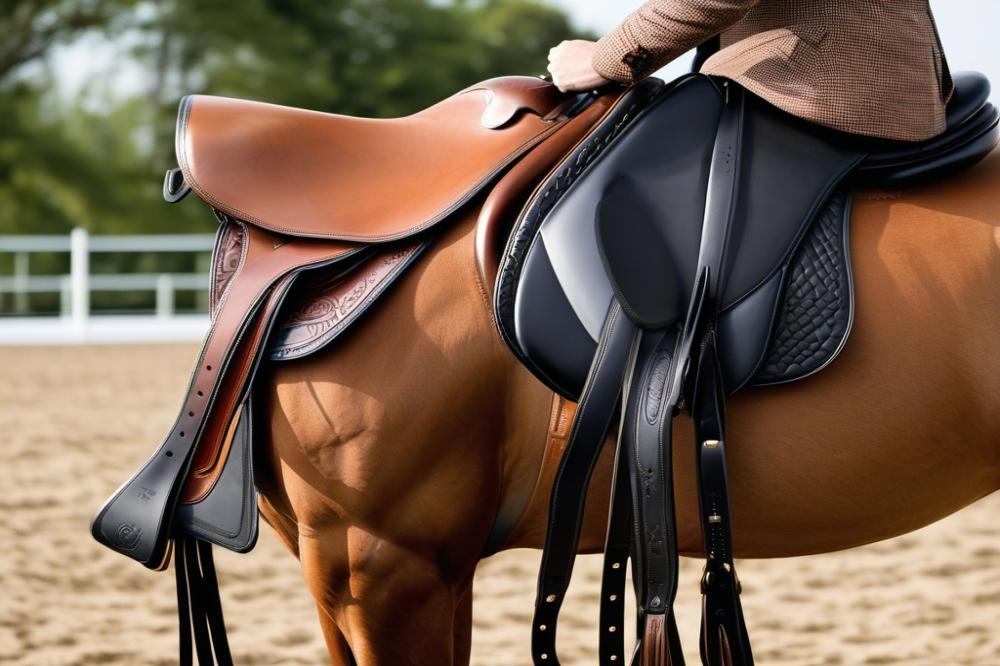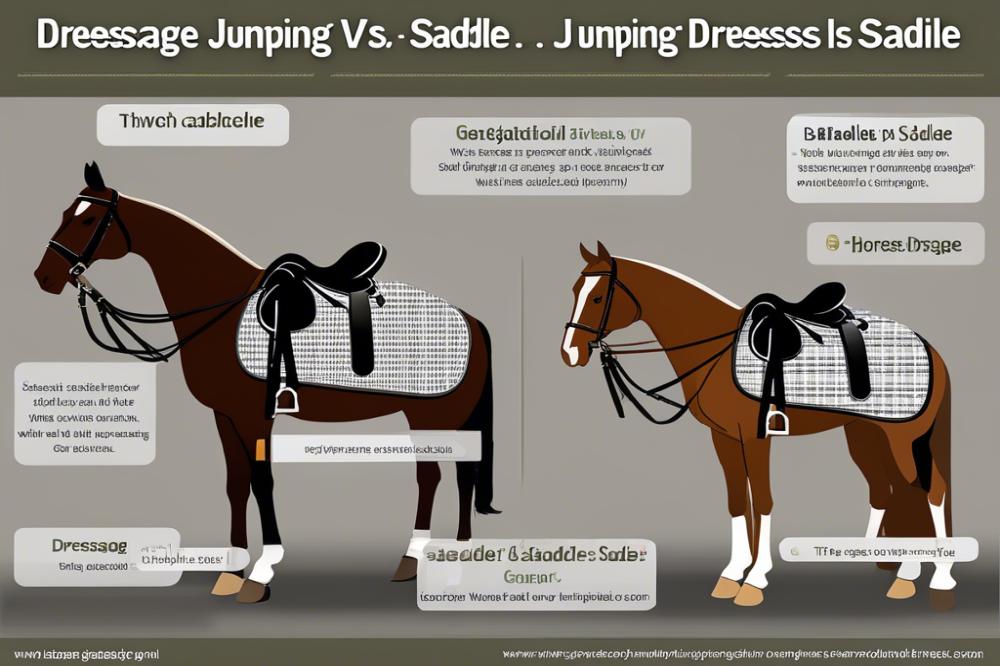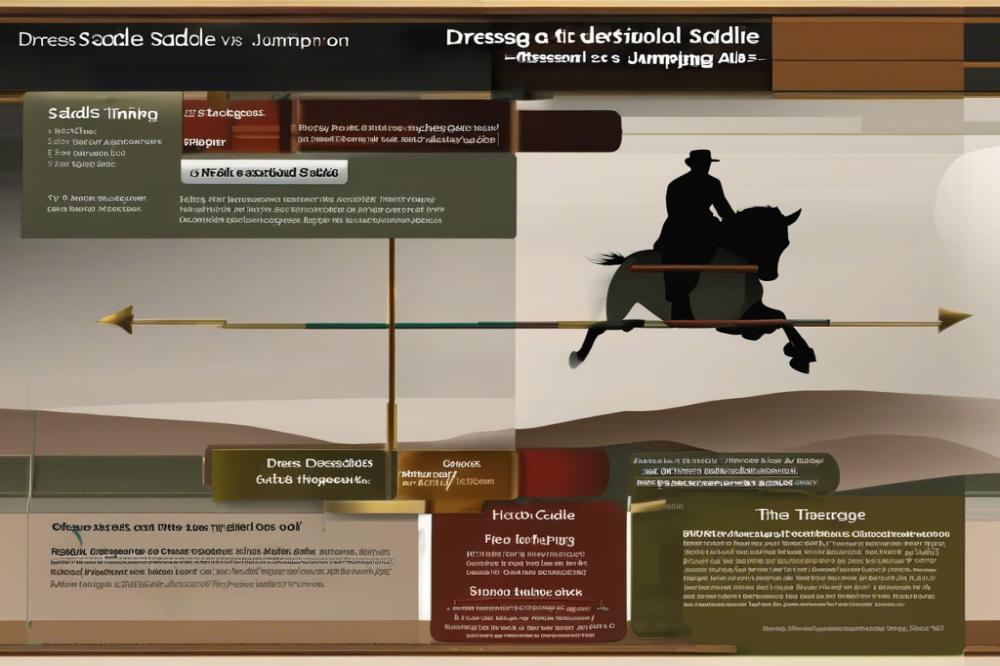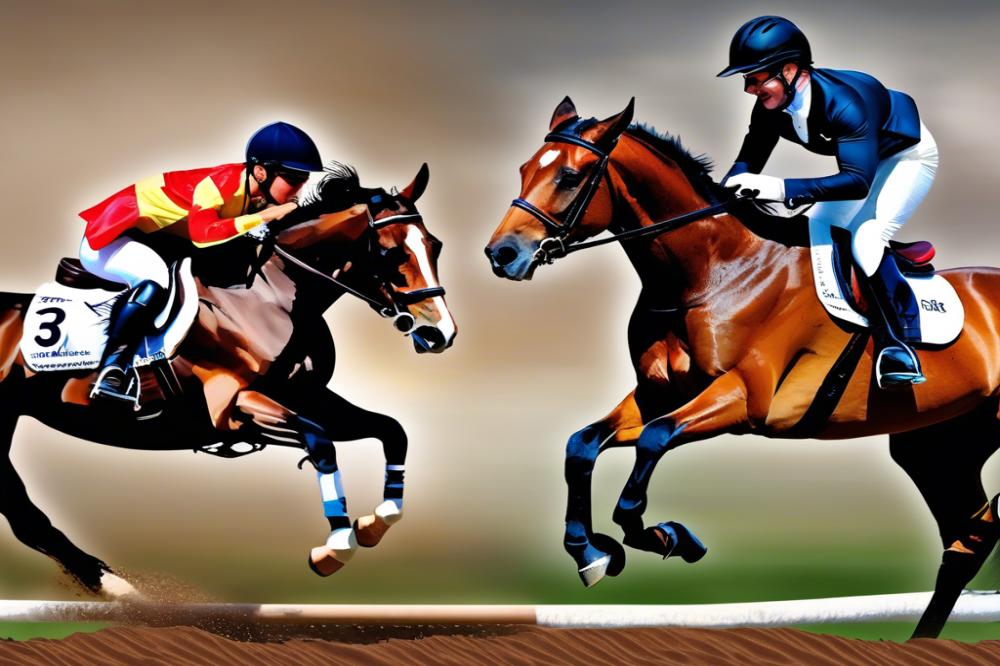Equestrian Sports: An Overview
Diving into the world of equestrian sports might feel like stepping into a different universe. From dressage and jumping to western riding, each discipline showcases an incredible bond between horse and rider. Enthusiasts often display not just skill, but passion that can only be matched by the agility of their horses. Many might liken it to a dance, with every movement needing precise timing and a bit of flair—much like a medieval knight dancing in armor!
The Significance of Saddle Selection

Selecting the right saddle is akin to choosing the perfect pair of shoes for a big event. The fit not only affects performance but also the comfort of both horse and rider. Just imagine trying to run a race in shoes that pinch or slip; it wouldn’t be fun, would it? Proper horse riding gear enhances both control and communication, which are crucial for effective horse training.
Understanding Dressage and Jumping Disciplines

When we talk about dressage, picture a beautiful ballet on horseback—grace, precision, and harmony. Riders perform specific movements that showcase their horse’s training and responsiveness. Jumping, on the other hand, is more like a thrilling roller coaster ride! Here, speed and agility come into play as horse and rider navigate a course filled with obstacles, showcasing a different set of equestrian techniques.
The Purpose of This Article

This article aims to shed light on the fascinating differences between dressage saddles and jumping saddles. A saddle comparison may seem trivial, but it’s essential for every rider to understand how their equipment can impact both performance and overall horse care. Whether you’re looking for the ideal fit for a spirited thoroughbred or checking the breeds of horses list for your next equine partner, getting it right is crucial. So grab a cup of coffee, sit back, and let’s explore the wonderful world of saddles tailored for these distinct equestrian adventures.
Understanding Dressage Saddles
Dressage saddles are a specific type of equestrian equipment designed for the art of dressage. The main purpose of these saddles is to provide the rider with a secure and balanced seat, which helps during precision movements and intricate patterns. Riders can communicate better with their horses while competing or training.
Key Features
The first thing you might notice about dressage saddles is the deep seat. This feature allows the rider to sit deeply, which is essential for maintaining control and stability. A lot of people liken it to sinking into a comfy chair, but it’s one that’s made for riding!
Another important aspect is the long flaps. These extend down the sides of the saddle, offering more support for the rider’s legs. This is especially helpful when working on those fancy dressage movements. Imagine trying to do a pirouette while keeping your legs steady. The long flaps help you look as polished as a ballet dancer on a stage.
Block positioning is another key feature to consider. Blocks refer to the padding that helps offload pressure on the rider’s legs. They are strategically placed to aid the rider in finding the perfect leg position. This ensures better communication with the horse, which is vital in horse training.
Materials and Construction
Manufacturers often use high-quality leather for dressage saddles, making them both durable and comfortable. A good saddle should last, just like a trusty pair of boots. The craftsmanship is usually top-notch, focusing on not just looks, but also function. Every stitch has a purpose!
Some saddles come with synthetic materials, which can be lighter and easier to clean. This makes horse care a bit simpler for busy riders. However, the traditional leather saddles have a charm that many equestrians adore. When you choose your horse riding gear, you often find yourself at a crossroads, deciding between performance and classic appeal.
Ultimately, a well-made dressage saddle is a crucial piece of equipment for anyone serious about their craft. It’s more than just a seat; it’s a connection between the horse and the rider, similar to the bond in a classic duet. Understanding these details allows riders to make a saddle comparison with more insight.
Understanding Jumping Saddles
Jumping saddles play a key role in the world of equestrian sports. Designed specifically for riders who love to leap over obstacles, these saddles are all about balance and stability. Their unique construction helps horses and riders work together during jumps.
Definition and Purpose of Jumping Saddles
A jumping saddle is made for one main reason: to support the rider during jumps. It allows a rider to maintain a proper position while navigating different obstacles. Imagine gliding gracefully over a fence, your saddle helping you stay secure in the process. This balance is essential for successful horse training and performance.
Key Features
Several distinct features set jumping saddles apart from others. The most noticeable is the forward seat. This design helps riders position themselves more effectively for jumps. When a rider leans slightly forward, they can better manage their horse’s movement.
The flaps on jumping saddles are shorter compared to those found on dressage models. Shorter flaps allow the rider’s legs to hang more freely, aiding in communication with the horse. This accessibility is critical when perfecting equestrian techniques.
Many jumping saddles come equipped with knee and thigh blocks. These added features help provide necessary support. Riders can find themselves in better positions and can react quickly during those thrilling moments. Think of these blocks as helpful sidekicks that keep you in control!
Materials and Construction
When discussing horse riding gear, consider the materials used in jumping saddles. High-quality leather is a popular choice because it offers comfort and durability. Some saddles might use synthetic materials for easier maintenance and lighter weight. Ultimately, the decision often depends on personal preference and riding style.
Craftsmanship also plays a role. Well-constructed saddles have a fine balance of strength and flexibility. They can withstand the demands of jumping while keeping the rider comfortable. Many riders spend time researching options and comparing different types in the market. Finding the right saddle can feel like a quest, but it’s worth every moment!
Differences in Design and Functionality
Comparison of Saddle Shape and Style
Dressage saddles and jumping saddles look quite different. A dressage saddle has a deep seat and long flaps. This design helps riders sit back and maintain proper posture. It encourages a smooth and elegant style for movements. On the other hand, jumping saddles have a flatter seat and shorter flaps. This allows riders to pivot easily when they fly over fences. The difference in shape feels like riding a couch versus a barstool. Each type of saddle is crafted for specific tasks in the equestrian world.
Impact on Rider Position and Balance
Rider position matters a lot. With a dressage saddle, the rider sits more vertically. This position helps the rider communicate better with the horse. Good communication is key in horse training. Jumping saddles, however, require a more forward position. Riders need to lean slightly ahead to prepare for jumps. Think about it like leaning into a gust of wind. You need to be focused and ready for action. Each saddle shape guides the rider’s body, influencing their balance significantly during different activities.
How Design Influences Performance in Each Discipline
The way a saddle is made plays a big role in performance. In dressage, the type of saddle aids in precision. Riders have to execute moves like half-passes and pirouettes. A well-fitted dressage saddle helps achieve these elegant movements. Jumping, conversely, demands a different set of skills. Jumping saddles let riders feel the horse’s motion under them. That connection is vital for quick decisions mid-jump. Poorly designed saddles can lead to problems, like missed jumps or lack of control. Choosing the right piece of equestrian equipment is essential for success, whether in the ring or on a course.
Rider Comfort and Performance
When it comes to equestrian equipment, a solid fit is key for both the horse and rider. Imagine trying to run a marathon in shoes two sizes too small. Not fun, right? That discomfort is magnified with horse riding gear. If a saddle doesn’t fit well, it can hurt your horse and distract you from reaching your full potential. A perfect saddle brings balance and stability, which are critical for effective communication with your horse.
The type of saddle you choose really shapes how effective you can be in the saddle. Dressage saddles provide a more fixed position, allowing the rider to focus on equestrian techniques without worrying about slipping. Jumping saddles, however, offer more freedom to move. They allow for quick changes in position while navigating obstacles. Each saddle has a designated role, impacting how you connect with your horse during training or competitions.
Consider those long hours spent in the saddle. Comfort becomes paramount after a few hours. Riders shouldn’t have to wiggle continuously to relieve pressure points. Choosing between these two types of saddles often comes down to personal preference and riding style. Remember, equestrian gear should support you and your horse on those mentally draining training days.
Plus, let’s face it: no one wants to spend hours in a seat that feels like a rock. The right choice can make a world of difference in endurance and focus. You’ll want to keep your mind on your horse care rather than being distracted by an uncomfortable saddle. So, think about what will keep you both happy on those long rides!
Choosing the Right Saddle
Factors to Consider
The choice of a saddle greatly depends on the type of riding you plan to do. Dressage enthusiasts need a different feel than those leaping over jumps. Discipline and horse type play a crucial role in this saddle comparison. For example, a dressage saddle often has a deeper seat and longer flaps, allowing for more control. On the other hand, a jumping saddle is designed for a forward position, making it easier to navigate obstacles. Your horse’s build also matters. Some horses might feel more comfortable in one type over another.
What about the rider’s level and goals? Beginners often find solace in a saddle that allows them to ride comfortably while developing their skills. If you aim to compete, you’ll want equipment that enhances your performance. Think about your aspirations! Whether it’s mastering equestrian techniques or aiming for a blue ribbon, your choice of horse riding gear should match your ambitions.
Tips for Trying Saddles
Trying a saddle can feel a bit like dating. You want to find the right fit! Start by visiting a trusted tack shop that carries various options. Don’t be shy about asking for assistance. It helps to have someone knowledgeable guide you. Sit in different saddles to see how they feel. Keep in mind that you should consider how they fit your horse too. Your companion’s comfort is just as important as your own. Take your time when deciding. This is an important investment in your horse training journey.
Common Misconceptions
There are plenty of misconceptions about saddles out there. One popular myth is that one size fits all. Unfortunately, that’s far from the truth! Each horse has its own shape and needs. Another fallacy is that you can use the same saddle for both disciplines. While some saddles can crossover, it’s often better to use the right one for the task. It’s like trying to use a hammer for everything—sometimes you just need a different tool! Don’t let stereotypes steer you wrong; your focus should be on your goals and what feels right for both you and your horse.
Maintenance and Care
Caring for equestrian equipment like saddles requires attention to detail. Before diving into specifics, let’s highlight some basic routines. A dressage saddle often sees less dirt than a jumping saddle, but both need regular cleaning. Wipe down the leather with a damp cloth after each use to remove sweat and dust. For jumping saddles, remember they might gather more mud due to their rigorous use. A gentle brush can help remove that muck.
Regular cleaning plays a huge role in the longevity of your saddles. It’s essential to check for any signs of wear or damage. Look closely at the leather for cracks or loose stitching. A small issue can turn into a big problem if not caught early. Inspecting your gear after every ride is a smart habit. This simple act can save you from unexpected repairs.
Storage is another vital aspect of horse care. How you store your saddles affects their shape and quality. Avoid leaving them in direct sunlight; that can dry them out and lead to cracks. Instead, find a cool, dry place to hang them properly. A saddle rack is excellent for this purpose. Covering them with a protective cover can keep dust and dirt at bay, too. Remember, each saddle serves its purpose in horse training, so take care of them like the valuable horse riding gear they are!
Wrapping It All Up
Choosing the right saddle is like picking the perfect pair of shoes. It can make all the difference in your riding experience! Understanding the difference between a dressage saddle and a jumping saddle is crucial for comfort, performance, and improving the bond between you and your horse. Each type of saddle has its own role, and knowing these distinctions can help you excel in your chosen discipline.
When contemplating which saddle to settle on, consider your riding style and the unique needs of your horse. Jumping saddles are designed for excitement and agility, giving you the stability needed when soaring over jumps. Conversely, dressage saddles promote grace and precision, ensuring your movements are fluid and controlled. Just like the ongoing debate of draft horse vs quarter horse, horse lovers have their favorites based on what they enjoy most. Remember, however, choosing the wrong saddle can lead to discomfort, and potentially affect your horse’s performance over time!
While it might be tempting to wing it and pick whichever saddle catches your eye, a thoughtful approach will serve you well. Advice from professionals—like trainers or saddle fitters—can provide valuable insights tailored to your situation. These experts can help ensure a proper fit for both you and your steed. Much like arranging a horse halter show, setting the groundwork begins with the right equipment! Too often, riders overlook how vital the right saddle is and end up dealing with issues that could’ve been avoided with a little guidance.
In the end, saddle selection truly matters. There’s no rush to make a decision. Take your time exploring options, trying out saddles, and discussing with knowledgeable folks. Your comfort, your horse’s comfort, and your overall riding experience are paramount. Dive into saddle shopping with enthusiasm and an open mind, and you’ll surely find what works best for you both. Happy riding!



